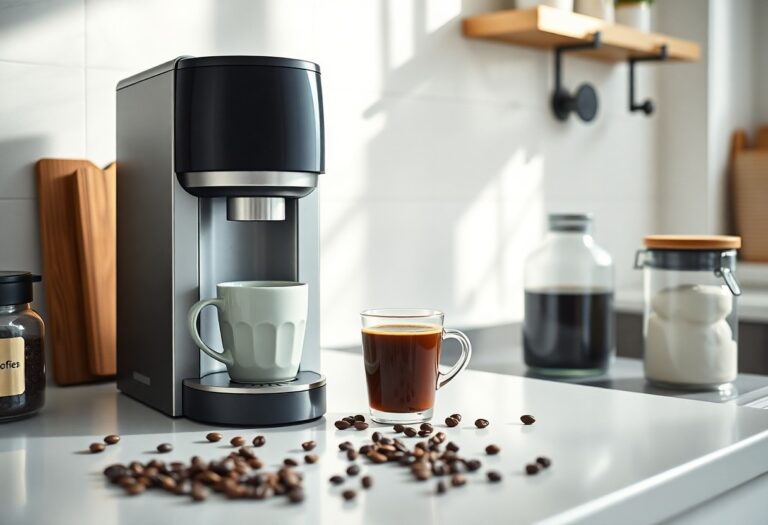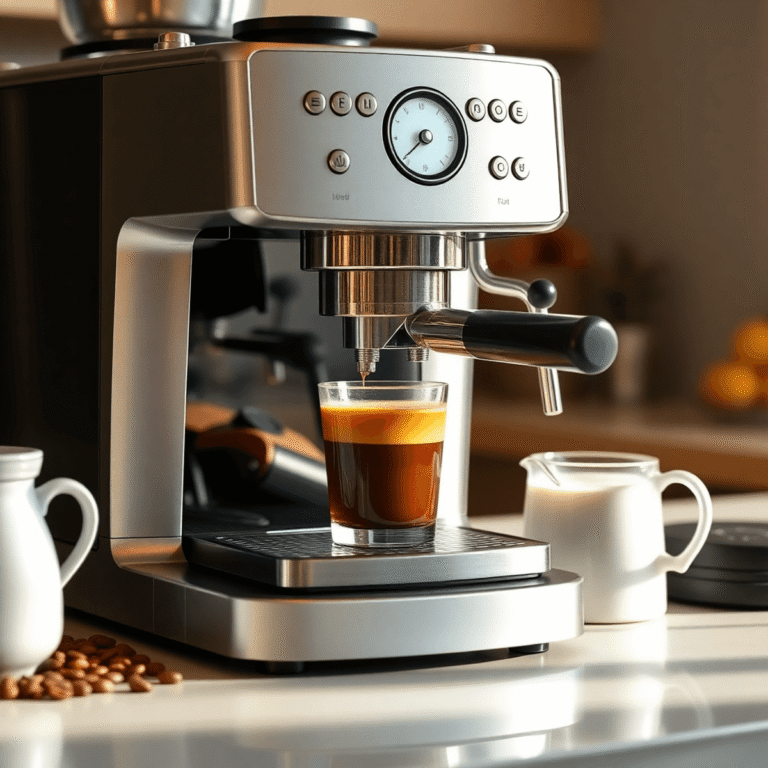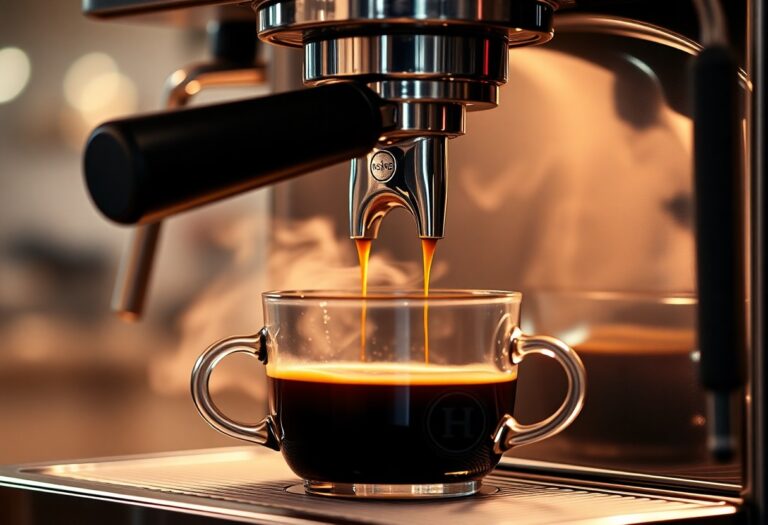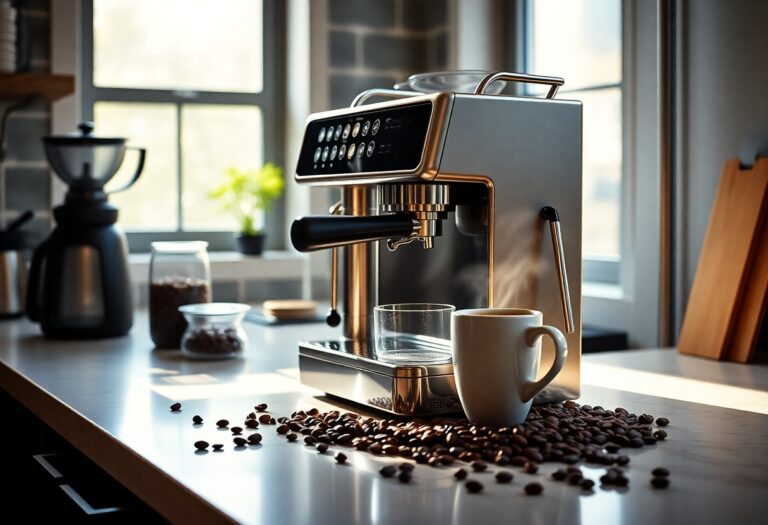How Much Coffee to Put in a Coffee Machine: Perfect Ratios
The coffee-to-water ratio is crucial in brewing, impacting flavor and strength significantly. This article explores expert-recommended ratios and how to tailor them to personal preferences. By mastering precise measurements and brewing techniques, you can achieve the perfect cup of coffee that suits your taste preferences perfectly.
However, achieving that perfect cup isn’t just about the right ratio. It’s also essential to maintain your coffee machine for optimal performance. For instance, cleaning your coffee machine with vinegar is a natural cleaning method that can enhance its longevity and efficiency.
If you’re using a K-cup coffee machine, knowing how to clean it is vital for maintaining its functionality. Similarly, understanding how to use a Keurig coffee machine can significantly improve your brewing experience.
Moreover, regular maintenance such as cleaning a Keurig coffee machine is essential to ensure it continues to function correctly and brew your coffee to perfection.
Understanding the Golden Ratio: 1:16
The 1:16 ratio refers to using 1 part of coffee to 16 parts of water in coffee brewing. This means for every gram of coffee, you would use 16 grams (or milliliters) of water.
Significance of the 1:16 ratio
Widely endorsed by the Specialty Coffee Association and many experts, the 1:16 ratio is considered an excellent starting point for most brewing methods. Research and experience have shown that this ratio can yield a well-balanced and flavorful cup of coffee.
Benefits of the 1:16 ratio
This ratio tends to produce a brew that is neither too weak nor too strong, appealing to a wide range of taste preferences. It strikes a harmonious balance between the rich flavors of coffee and the subtleties brought out by proper extraction methods.
By understanding and applying the 1:16 ratio in your coffee brewing routine, you can embark on a journey towards consistently enjoying a well-rounded and satisfying cup of coffee that exemplifies the expertise and precision involved in achieving the perfect brew.
If you’re using a Keurig machine, it’s essential to also know how to [descale it properly](https://www.coffeemakerexpert.com/how-to-descale-a-keurig-coffee-machine-complete-step-by-step-guide) for optimal performance. Similarly, if you’re utilizing other types of coffee machines like Krups or standard coffee makers, familiarizing yourself with [cleaning and maintenance](https://www.coffeemakerexpert.com/how-to-clean-a-krups-coffee-machine-maintenance-guide) or descaling these machines can significantly improve your brewing results.
Customizing Your Brew: Adjusting Ratios for Taste Preferences
When it comes to brewing the perfect cup of coffee, it’s all about personal preference. The standard coffee-to-water ratio is typically around 1:16, but this can be adjusted to suit your taste. If you prefer a bolder and [stronger brew](https://www.coffeemakerexpert.com/how-to-use-a-coffee-machine-basic-operation-instructions), consider using a slightly higher ratio, such as a 1:15. On the other hand, if you’re in the mood for a milder and [lighter brew](https://www.coffeemakerexpert.com/how-to-use-a-mr-coffee-machine-complete-operating-guide), you might want to experiment with a lower ratio like 1:18.
Don’t be afraid to experiment with different ratios within this reasonable range to find your personal sweet spot. Remember, the key to a great cup of coffee lies in the balance between the coffee and water, so take your time to find what works best for you!
The Importance of Precision in Measurement Techniques
Achieving consistent and repeatable results when brewing coffee at home depends heavily on accurate measurements. Knowing how much coffee to put in a coffee machine is just the starting point. Precision in measuring coffee grounds ensures that each cup you make matches your desired strength and flavor profile.
Measuring by weight with a kitchen scale stands out as the most reliable method for several reasons:
-
Consistency: Coffee beans vary in density and grind size, which affects volume measurements. A tablespoon of finely ground coffee weighs more than the same volume of coarse grounds. Using a scale eliminates this variability by measuring the actual mass.
-
Repeatability: Once you find your ideal coffee-to-water ratio, weighing allows you to replicate the exact amount every time, avoiding guesswork or adjustments based on inconsistent scoops.
-
Accuracy: Volume measurements like tablespoons or scoops can be misleading because they depend on how tightly packed or unevenly ground the coffee is. Weight measurements remove this uncertainty.
Experts, including those from the Specialty Coffee Association, recommend weighing coffee to hit precise ratios such as 1:16 (coffee to water). This practice takes the guesswork out of brewing and helps maintain quality whether you’re making a single cup or a full pot.
Using kitchen scales has become increasingly affordable and easy to use, making it accessible for everyday brewers who want to improve their coffee experience. It’s worth investing in a good scale if you want to master perfect ratios consistently.
Accurate measurement techniques form the foundation for dialing in your brew. Understanding how much coffee to put in your machine with precision supports better flavor extraction and ultimately leads to a more satisfying cup every time.
However, it’s not just about the measurements. The type of coffee machine you use also plays a crucial role in your brewing process. For instance, if you’re using a Ninja coffee machine, understanding how to clean it properly can significantly enhance its performance and longevity.
Similarly, if you’ve opted for a Cuisinart model, knowing how to use it effectively can make your brewing experience smoother.
For those who prefer Bunn coffee machines, mastering professional maintenance techniques is essential for maintaining optimal functionality.
Lastly, regardless of the brand or model of your coffee machine, following personal maintenance guidelines will ensure that your machine continues to deliver great tasting coffee consistently.
Using Tablespoons as a Substitute for Weighing Coffee Grounds
When precision tools like kitchen scales are not available, using tablespoons can serve as a convenient substitute for measuring coffee grounds. While not as accurate as weighing, this method can still yield decent results, especially for those looking to enjoy a good cup of coffee without the need for specialized equipment.
To help you make the most of this makeshift approach, here are some rough conversions to keep in mind:
- 1 tablespoon ≈ 5-7 grams of coffee
- 1 cup of brewed coffee ≈ 6-8 ounces (180-240 milliliters)
By using these estimations, you can roughly gauge the amount of coffee needed based on your preferred strength and taste preferences. For example, if a recipe calls for 20 grams of coffee but you don’t have a scale, you could opt for approximately 3-4 tablespoons instead.
However, if you’re using a specific type of coffee maker like a Keurig or Ninja, it’s worth noting that these machines often come with their own measuring guidelines. For instance, Keurig machines typically use pods which have a standard amount of coffee in them. On the other hand, Ninja coffee machines allow for more flexibility in terms of measurement and brewing style.
Remember that these conversions are approximate and may vary based on factors like coffee bean size, grind consistency, and personal taste. Experimenting with different spoonfuls until you find the right balance can help you tailor your brew to suit your individual palate.
While using tablespoons is more about estimation than precision, it can still be a practical method for casual home brewing or when traveling without access to specialized tools. Flexibility and adaptation are key when it comes to making great coffee in any setting. And if you’re unsure about how to maintain your machine or clean it properly, there are numerous resources available online such as [how to clean a Cuisinart coffee machine](https://www.coffeemakerexpert.com/how-to-clean-a-cuisinart-coffee-machine-step-by-step-instructions), cleaning tips for Mr. Coffee machines, or essential maintenance tips for any coffee machine.
Considering Brewing Method Variances When Determining Ratios
Different brewing techniques require adjustments to the coffee-to-water ratio because of variations in extraction times and how water interacts with coffee grounds.
Extraction time plays a crucial role. Pour-over methods generally involve longer, controlled contact between water and coffee, often with a steady pour that allows for gradual extraction. This approach typically calls for a slightly finer grind size to maximize flavor release without over-extraction. The ideal coffee-to-water ratio here tends to lean towards something like 1:16 or 1:17, balancing clarity and brightness in the cup.
In contrast, full immersion methods such as the French press work differently. Coffee grounds are fully immersed in water for several minutes, resulting in more extended extraction overall. The grind size used is usually coarser to prevent excessive bitterness and sediment in the cup. Because of this prolonged contact, the coffee-to-water ratio is often adjusted to be stronger (around 1:15 or even 1:14) to compensate for the dilution effect and extract richer flavors. If you’re interested in exploring this brewing method further, you can find a comprehensive French press coffee machine brewing technique guide here.
| Brewing Method | Typical Grind Size | Extraction Time | Common Ratio |
|---|---|---|---|
| Pour-over | Fine | Longer, controlled | 1:16 – 1:17 |
| French Press | Coarse | Full immersion (4-5 min) | 1:14 – 1:15 |
These differences highlight why the same ratio doesn’t fit all brewing styles perfectly. Adjusting your coffee dose based on the method you choose ensures better extraction control and an improved final taste profile.
Understanding how brew technique affects your ideal ratio helps you tailor every cup to your liking while respecting the unique characteristics each method brings to the table.
Practical Guidelines for Adjusting Ratios Based on Brewing Method Used
Precision measurement remains key when you want consistent flavor and strength in your coffee. Understanding how the brewing method influences the ideal coffee-to-water ratio helps you make informed adjustments. Different methods extract flavors at varying rates, so adapting your ratio improves the overall cup quality.
Here are practical tips to guide you:
1. Pour-over
Start with the classic 1:16 ratio. This method uses a finer grind and longer contact time with water, allowing balanced extraction without bitterness. If your brew tastes weak, try tightening the ratio slightly to 1:15.
2. French press
Use a stronger ratio like 1:14 or even 1:13. Full immersion means coffee grounds steep directly in water, extracting more intensely over several minutes. A higher coffee concentration avoids a thin or underwhelming cup.
3. Drip coffee makers
Stick close to 1:16 but adjust between 1:15 and 1:17 based on strength preference and machine specifics. Many machines’ “cups” differ from standard measurements, so weigh coffee if possible for accuracy. For detailed instructions on how to use a filter coffee machine, refer to our comprehensive guide.
4. Aeropress
Ratios vary widely depending on recipe and immersion time; common range is from 1:12 to 1:17. Experiment within this range while maintaining precision in measurements to find what suits your taste best.
5. Cold brew
Use a coarser grind and ratios around 1:8 to 1:10 for the concentrate before dilution. Longer steep times require more coffee per water volume to achieve rich flavor.
Consistency depends on weighing coffee grounds rather than relying solely on volume measures like tablespoons. Scales provide repeatability across different methods, making strength adjustment easier and more reliable.
Adjusting ratios is not about strict rules but about balancing precision measurement with personal preference and brewing style. This approach answers the question of How Much Coffee to Put in a Coffee Machine: Perfect Ratios by tailoring each brew to its unique characteristics.
If you’re interested in exploring [manual brewing methods](https://www.coffeemakerexpert.com/how-to-make-coffee-without-a-machine-manual-brewing-methods), there are numerous resources available that can provide valuable insights. Additionally, understanding the necessary [ratios for cleaning a coffee machine](https://www.coffeemakerexpert.com/how-much-vinegar-to-clean-a-coffee-machine-proper-ratios) can also enhance your overall coffee experience.
For those who prefer espresso, our brewing guide can provide useful tips for achieving the perfect shot.
Conclusion
While there are general guidelines for determining appropriate coffee-to-water ratios, personal preference is crucial for achieving the perfect cup.
Don’t just stop at experimenting with different ratios; also consider variables like grind size, water temperature, and brew time for enhanced results.







